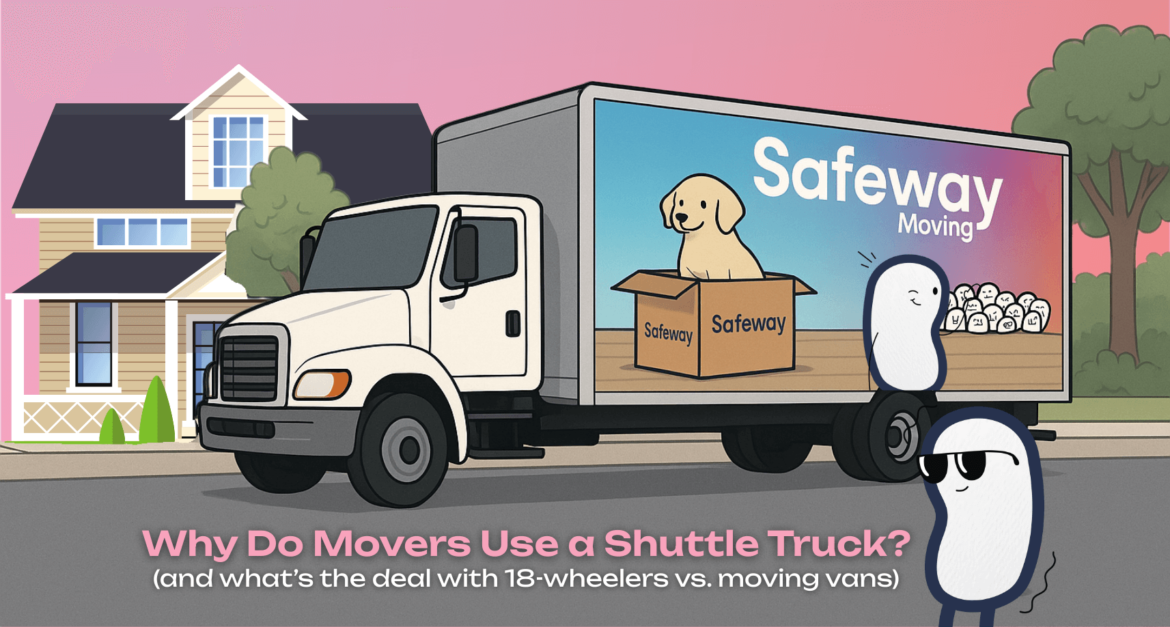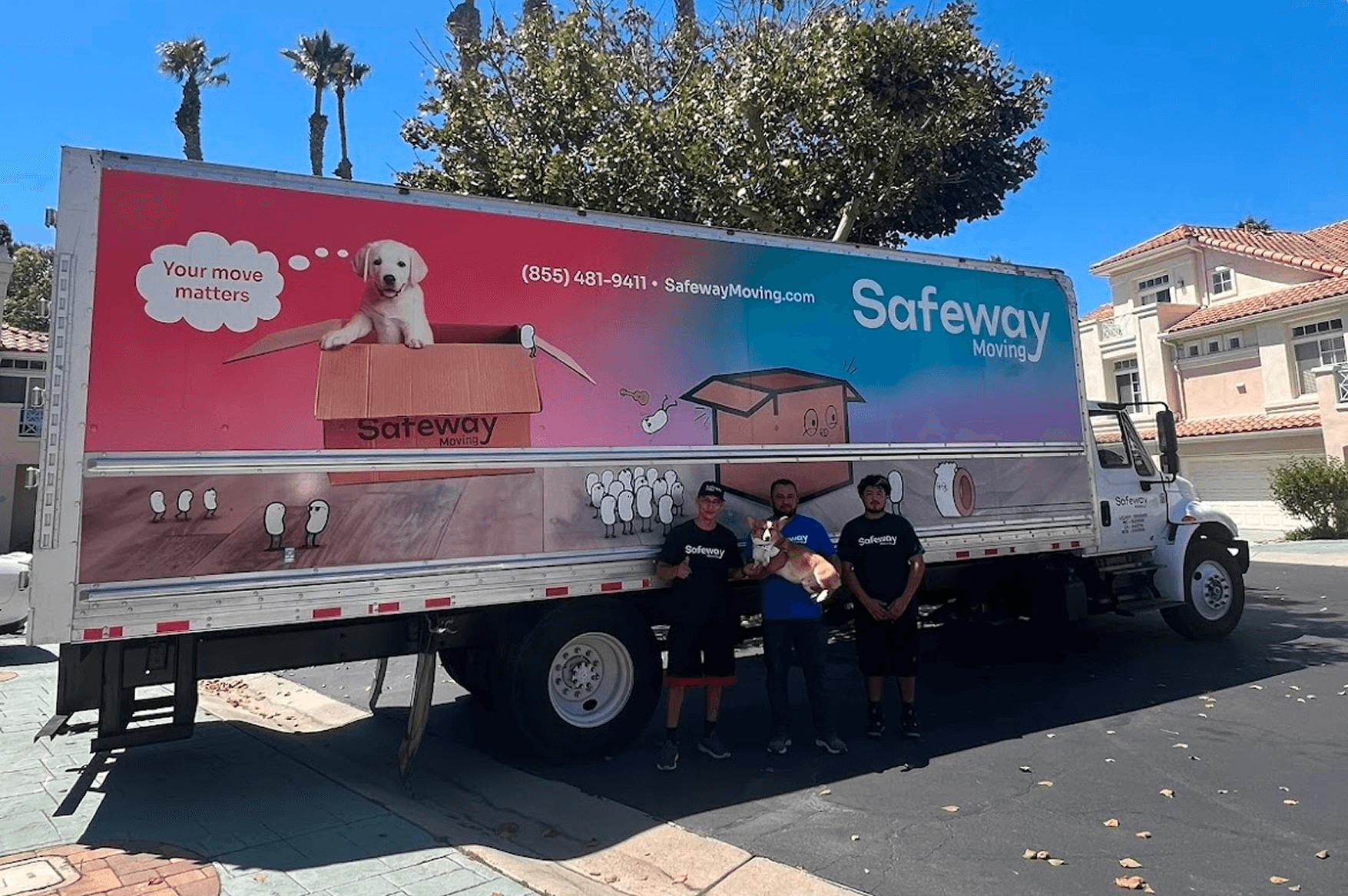
At Safeway Moving Inc., we know that long-distance moves can feel overwhelming. There’s a lot to manage — and then, just when you think everything is on track, your moving coordinator lets you know that a shuttle truck might be needed at delivery.
We get it — it sounds like an extra step, maybe even an extra cost, and it probably has you wondering:
- Why can’t the big truck just come straight to my home?
- What even is a shuttle truck?
You’re not alone in asking these questions, and we’re here to break it all down for you in plain language — no confusing trucking jargon, just the facts, with some real-world examples to help it make sense.
First Off, What Is a Shuttle Truck?
When we talk about a shuttle, we’re referring to a smaller moving truck that helps bridge the gap between the main long-haul truck (the big one that goes cross-country) and your front door.
Sometimes the 18-wheeler we use for long-distance moves can’t physically access your home — whether because of tight roads, low-hanging trees, or just no space to park. In those cases, we transfer your items from the big truck to a smaller shuttle, which can safely complete the delivery.
Think of it like using a dinghy to get from a cruise ship to shore — it’s not because we want the extra step, but because it’s the only safe, practical way to reach your destination.
Why Can’t the Big Truck Just Come to My House?
This is a great question, and the answer is: sometimes it simply can’t.
Here are some of the real-world challenges that can prevent our long-distance trucks from accessing your home directly:
Low-Hanging Trees
Tree branches that stretch over the road might be no big deal for your SUV, but they can be a serious hazard for a tall moving trailer. These trucks can be over 13 feet tall — and even one low-hanging limb can cause scratches, dents, or worse.
Low Bridges or Overpasses
Some areas, especially in older cities or rural towns, have bridges that are too low for a large trailer to pass under safely. We can’t take the chance of hitting a bridge — it’s a risk to the truck and your items inside.
Steep or Winding Roads
Mountainous terrain or twisty neighborhood roads make maneuvering a 70-foot vehicle nearly impossible. The length, weight, and turning radius of the truck just aren’t designed for it.
Narrow Streets and Tight Turns
Many residential neighborhoods, especially in urban areas, weren’t built with 18-wheelers in mind. Even if we could get the truck in, we might block driveways, mailboxes, or traffic — or worse, damage property.
No Parking or Turnaround Space
A fully loaded tractor-trailer needs a lot of space — and cul-de-sacs, dead ends, or busy city streets often don’t provide enough room to safely park or back out.
In all of these situations, using a shuttle is not just smart — it’s necessary to protect your belongings, your neighborhood, and the truck itself.

Okay, But What’s the Difference Between an 18-Wheeler and a Moving Van?
This part confuses a lot of folks — and understandably so! Most people think of all big trucks as 18-wheelers, but in the moving world, not all large trucks are built the same.
Let’s clear it up:
The Typical Freight 18-Wheeler (What You See on Highways)
These are the trucks you see hauling cargo across the country for major freight companies. They’re designed to move pallets of goods, not furniture.
- Trailer height: Very tall, with a higher floor off the ground. That means steep ramps and more risk when loading delicate items.
- Wheels: 18 total (hence the nickname), with tandem axles for heavy freight loads.
- Interior: Not padded, not climate-controlled, and not designed for furniture.
- Access: Often requires a forklift or loading dock.
These trucks are perfect for warehouse-to-warehouse shipping, but not ideal for residential moving.
Moving Van Tractor-Trailer (What Safeway Uses)
Our long-distance moving trailers might look similar on the outside, but they’re purpose-built for household goods.
- Lower floor height: Easier, safer loading and unloading of furniture. However this may cause some roads to be inaccessible such as driveways that are steep (with a lower floor height the bottom of the trailer is much closer to the road).
- Interior: Fully padded walls, straps, and air ride suspension to protect your belongings from bumps and vibrations.
- Designed for furniture and boxes: We don’t stack your dining table under heavy crates or forklifts.
- Still large: These are still big trucks — up to 53 feet long — but they’re tailored for moving homes, not freight.
So while both types of trucks are big rigs, our moving vans are built specifically to keep your belongings safe, clean, and intact during long-distance transport.
Does Using a Shuttle Cost Extra?
Sometimes, yes — but it’s not about hidden fees or surprise charges. The shuttle process involves:
- Renting a second, smaller truck
- Paying for additional labor to transfer your items
- Extra time and fuel. A driver often spends 7 hours completing a shuttle move. from parking, to finding a rental truck, unloading carefully and reloading into the shuttle.
- Parking the tractor and trailer while the drive shuttles your belongings.
But we always aim to be upfront and transparent. If we anticipate needing a shuttle, we’ll let you know as early as possible, explain why, and go over any associated costs before anything is confirmed. No surprises, just solid communication. With Safeway your final cost for a shuttle is often 25-40% cheaper than working with any other company.
What Happens During a Shuttle Move?
If a shuttle is required, here’s how it works:
- The main moving truck parks in a nearby accessible location. This could be a large parking lot, a wide street nearby, or another spot where it’s safe and legal to unload.
- We transfer your belongings to the shuttle truck — carefully, securely, and with the same care we used during packing. Nothing gets tossed or rushed. Every item is still wrapped, padded, and handled by our professional crew to make sure it’s protected.
- The shuttle drives the last mile to your front door. Once it arrives, we unload your belongings just like we would if the big truck had made it all the way — placing things where you want them and checking to make sure nothing is missing or damaged.
It’s the same great service — just with one extra step to safely get your things where they need to go.
Why Safeway Plans Ahead for Shuttle Needs
One of the biggest advantages of working with Safeway Moving Inc. is that we don’t wait until the last second to figure this out. Our team does the homework upfront.
We use mapping tools, driver feedback, and years of experience to anticipate when a shuttle might be needed. We’ll ask the right questions about your delivery address, check satellite images, and even confirm local access restrictions so there are no last-minute surprises.
If there’s any chance that the big truck can’t make it, we’ll let you know well in advance and walk you through the plan. Clear communication is part of how we make moving feel just a little less stressful.
A Final Word from the Road
We know that moving is a big deal — your home is full of things that matter, and you want the process to go smoothly. Using a shuttle truck might sound like an inconvenience at first, but in reality, it’s one of the ways we ensure your move goes off without a hitch.
At the end of the day, a shuttle isn’t a complication — it’s a solution. It’s how we safely and efficiently navigate tricky roads, tight spaces, and unexpected obstacles so that your belongings arrive safe and sound at your new front door.
If you have any questions about your upcoming move, your delivery address, or whether a shuttle might be necessary, don’t hesitate to reach out. Our friendly team is here to help, every step of the way.










